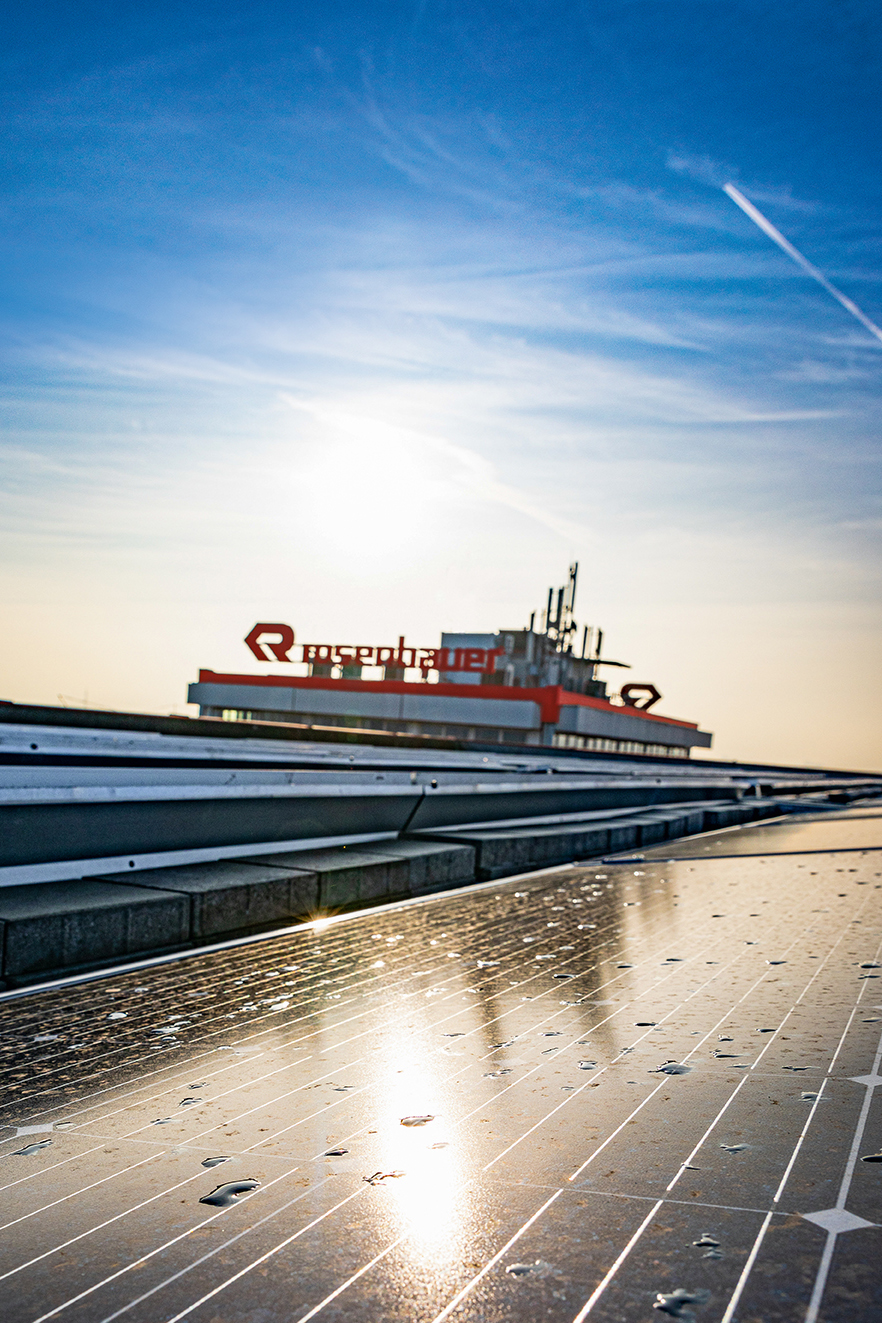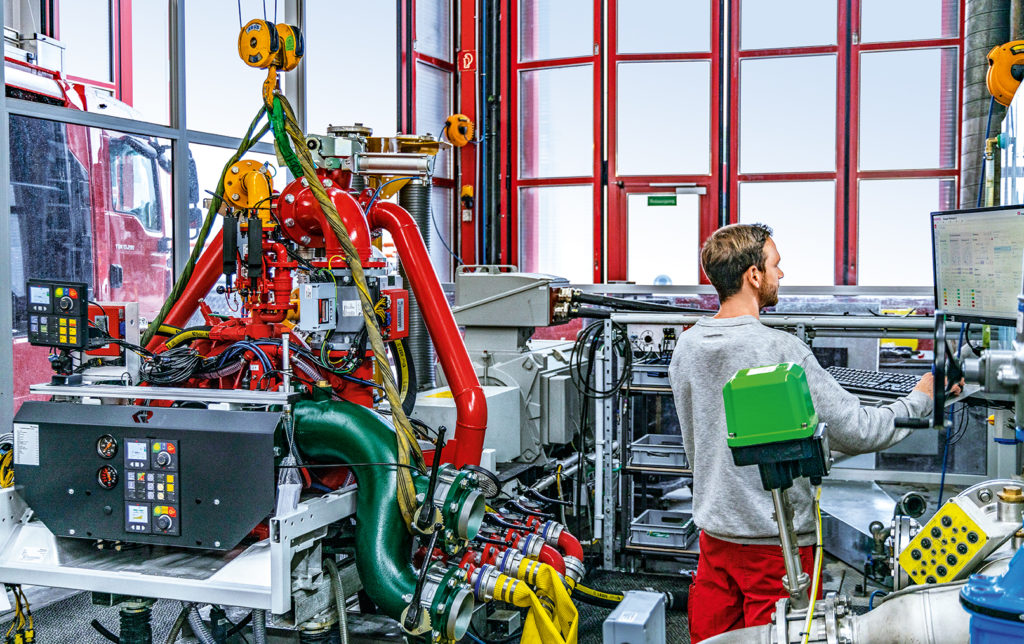Environmentally friendly Production
Rosenbauer takes responsibility for its products and the environment. That starts in Production. The company pays particular attention to using green electricity, reducing heat, fuel and water consumption, replacing energy-intensive equipment with energy-efficient alternatives, and preventing waste.

New environmentally friendly pump test stand


Rosenbauer’s production activities primarily involve machinery and specialty vehicle assembly, and/or metal and plastics processing. It is a priority for Rosenbauer to take action in these areas, particularly in the material topics of Energy efficiency and reduction of greenhouse gas emissions and Resource consumption in production.
ENERGY EFFICIENCY AND REDUCTION OF GREENHOUSE GAS EMISSIONS
To continuously optimize its energy footprint, Rosenbauer analyzes and estimates all relevant workflows, machinery, buildings, and processes according to their energy efficiency and develops corresponding measures to increase it.
The Rosenbauer Group’s energy requirement in the reporting year totaled 62,980.6 MWh (19 kWh per productive hour) and therefore decreased slightly in relation to 2019. Generally, production sites with paint shops use the most process and heating energy. Sales, assembly, and customer service operations account for most of our fuel consumption. Locations where the buildings and factory spaces require year-round cooling consume relatively high levels of electricity.
Renewable sources supply 65.9% of the electrical energy, while 6.9% of that is from the in-house cogeneration plant in Leonding and the photovoltaic systems in Mogendorf, Neidling and Leonding. District heating, which is largely generated from waste heat, in turn provides 24.6% of the process and heating energy used. Diesel accounts for 90.9% of the fuel used.
Climate Action and Reduction of Greenhouse Gas Emissions
To reduce its overall energy consumption, Rosenbauer uses waste heat from production to heat its paint shops. These facilities are continually modernized. Leonding plant I in turn uses the waste heat from the paint shop to heat the office buildings. Leonding plant II has used district heating since 2016, and Leonding plant I was connected to district heating in 2020. The Karlsruhe location has also been heated with district heating since 2016.
| Greenhouse gas emissions of Rosenbauer Group (in t CO2eq)* | Market-based | Country-based | ||||
|---|---|---|---|---|---|---|
| 2020 | 2019 | 2018 | 2020 | 2019 | 2018 | |
| Total Scope 1 + Scope 2 | 14,003 | 15,951 | 14,782 | 17,335 | 19,017 | 17,717 |
| Direct greenhouse gas emissions (Scope 1) | 8,776 | 10,260 | 9,430 | 8,776 | 10,260 | 9,430 |
| Indirect energy-related emissions (Scope 2 resulting from the use of district heating and electricity) | 5,227 | 5,691 | 5,352 | 8,559 | 8,758 | 8,287 |
* Data in CO2 equivalents in accordance with the GHG Protocol Corporate Standard, taking into account the following greenhouse gases: CO2, CH4, N2O, SF6, HSCs, PFCs, NF3; without consideration of biogenic greenhouse gases.
Rosenbauer uses emission factors from the Environment Agency Austrian and the ecoinvent 3.6 database to calculate greenhouse gas emissions. The values for global warming potential are based on the IPCC Fifth Assessment Report (2013).
| Energy consumption of Rosenbauer Group | 2020 | 2019 | 2018 |
|---|---|---|---|
| Total* | |||
| MWh | 62,980.6 | 67,485.1 | 63,024.1 |
| kWh per prod. hour | 19.0 | 19.3 | 19.5 |
Electricity |
|||
| MWh | 16,011.2 | 16,530.0 | 15,541.9 |
| kWh per prod. hour | 4.8 | 4.7 | 4.8 |
Heating |
|||
| MWh | 31,310.1 | 34,099.3 | 30,524.6 |
| kWh per prod. hour | 9.5 | 9.8 | 9.5 |
Fuels |
|||
| MWh | 15,659.3 | 16,855.9 | 16,957.6 |
| kWh per prod. hour | 4.7 | 4.8 | 5.2 |
Increase in Green Electricity and Electricity Generated by the Company
The share of green electricity has already been increased to 65.9%. The large production locations in Austria and Germany in particular have been operated using 100% green electricity since 2019.
The goal of covering 5% of total electricity needs with photovoltaic systems by 2021 is expected to include both self-generated energy and electricity from systems on rooftops that are rented by Rosenbauer. The output of the existing photovoltaic systems at the Leonding, Neidling, and Mogendorf locations already covers 4.2% of the Group’s total electricity requirements. It is planned to check further sites for their suitability for photovoltaic systems in the coming years.
Status Goal Share of green electricity
Employee Mobility
Rosenbauer’s commitment to the environment includes providing alternative and sustainable forms of transportation for employees. As early as 2019, the Carployee ride sharing app was introduced at the locations in Upper Austria. This enables employees to ride together to and from work, thereby saving money. And it is an environmentally friendly way to commute. Rosenbauer promotes this initiative by providing benefits to active users. Since the project’s introduction, employees have traveled more than 800,000 km fewer on the roads, which corresponds to around 106 metric tons of carbon emissions. The number of users has increased by nearly 51% overall. During the COVID-19 pandemic, especially during the months of lockdown, active use of the app declined.
RESOURCE CONSUMPTION IN PRODUCTION
As a producer of firefighting vehicles, Rosenbauer needs aluminum and steel as primary raw materials. Both materials are easy to recycle but manufacturing them consumes a great deal of energy. Rosenbauer minimizes surface treatments so that the materials can be recycled as far as possible without slags. Other important raw materials come from the plastics industry. Chassis and manufacturing material make up the largest share of the Group’s procurement volumes; everything else is materials required in Assembly. Rosenbauer buys almost exclusively prefabricated, mostly ready-to-install parts: for vehicle superstructures these are primarily aluminum sandwich panels, aluminum sheets and profiles, and for vehicle trims and design fairings, preformed parts made of plastic, the raw materials for which are often precolored by the supplier in the vehicle color. Aluminum, stainless steel or gunmetal housing is used for firefighting pumps. The pump shaft and other pump units are procured as steel blanks and finished in-house.
Rosenbauer supplies a wide range of extinguishing systems as well as high and ultra-high pressure pumps for efficient extinguishing with less water. Considerable amounts of water are used over the course of numerous quality tests during the manufacture of firefighting pumps. For this reason, one of Rosenbauer’s chief concerns is to ensure the careful use of this resource, for instance by refurbishing pump test stands to make resource use more efficient.
In 2018, Rosenbauer began using only non-water-based paints free of heavy metals in production. This both reduces environmental pollution and preserves employee health.
Total Water Consumption in Production
Leonding plant I has the highest water requirement of any location in the Group. This is where Rosenbauer produces all pumps and extinguishing systems that must be tested with water as part of quality assurance. Water is also required for vehicle deliveries to demonstrate the extinguishing functions for customers. This is the case at most Rosenbauer production locations worldwide. On the pump test stands, where every unit from the smallest portable pump to the highest-volume truck-mounted fire pump is subject to a one-hour endurance test, the required water is recirculated. Depending on the pump capacity, this saves between 30 and 780 m3 of fresh water in each test cycle. Since around 3,000 units are tested per year, this saves an enormous volume of water.
The water used by Rosenbauer contains only very minimal contaminants. At all locations, waste water is of sufficient quality and is therefore released into the public sewer system. In addition, water purification facilities, such as mineral oil separators, are installed at several locations. This keeps the environmental impact of waste water as low as possible.
In the reporting period, the Rosenbauer Group’s total water consumption amounted to 84,497.1 m3, which is equal to specific water consumption of 25.5 liters per productive hour. 46.7% of the water consumed came from Rosenbauer’s own wells, the rest from the municipal supply. Compared with the previous year, total water consumption decreased by around 6%.
| Water consumption of Rosenbauer Group (m3) | 2020 | 2019 | 2018 |
|---|---|---|---|
| Municipal | 45,060.1 | 42,944.9 | 37,989.7 |
| Liters per prod. hour | 13.6 | 12.3 | 11.8 |
| Wells | 39.437,0 | 47,341.0 | 39,848.0 |
| Liters per prod. hour | 11.9 | 13.5 | 12.3 |
| Total* | 84,497.1 | 90,285.9 | 77,837.7 |
| Liters per prod. hour | 25.5 | 25.8 | 24.1 |
Total Volume of Waste
The volume of waste produced by the Rosenbauer Group in 2020 was around 3,917 t (1.2 kg per productive hour). Around 6% of the waste was hazardous, such as paints, solvents, batteries and used oils. Residual waste for disposal accounted for 6% of the total. All other used materials and waste were recycled. Specifically, this included aluminum, steel, recyclable plastics and cable residues, wood, glass, cardboard and paper. The figures are partly based on estimates, as not all locations keep detailed records. For waste disposal, Rosenbauer recycles as a matter of course and relies on local conditions and suppliers at all locations.
Waste collection islands are distributed over the entire site at every location and enable accurate separation of the waste and residual materials accumulating in each area. Final disposal is carried out by authorized specialists. Regular training is conducted to promote and increase awareness among employees. The motto here is “avoidance before separation, separation before recycling, recycling before disposal”. A specific measure implemented at the service location in France and a production location in Germany, for example, was replacing disposable cloths for cleaning oil residue with reusable cloths washed by a cleaning service.
| Waste of Rosenbauer Group | 2020 | 2019 | 2018 |
|---|---|---|---|
| Total* | |||
| t | 3,917.1 | 3,450,0 | 3,668.1 |
| kg per prod. hour | 1.2 | 1.0 | 1,1 |
| t | 233.3 | 178.3 | 160.2 |
| kg per prod. hour | 0.1 | 0.1 | 0.1 |
| Recyclable waste* | |||
| t | 3,452.5 | 2,966,9 | 3,197.8 |
| kg per prod. hour | 1.0 | 0.9 | 1.0 |
| Residual waste | |||
| t | 231.3 | 304.8 | 310.0 |
| kg per prod. hour | 0.1 | 0.1 | 0.1 |
* Used material, non-hazardous waste without residual waste